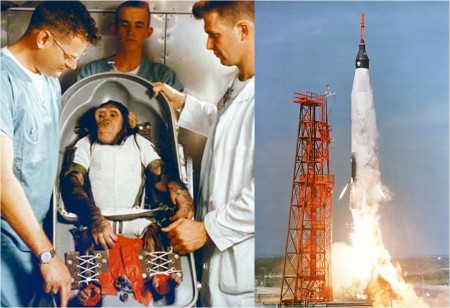Fifty-one years ago this month, a Cameroonian chimpanzee by the name of Enos successfully flew a two-orbit mission around the Earth during the flight of Mercury-Atlas 5 (MA-5). This important mission paved the way for America’s first manned orbital spaceflight in February of 1962.
Project Mercury was the United States’ first manned spaceflight program. It consisted of two (2) suborbital and four (4) orbital manned missions flown between May 1961 and May 1963. These manned missions were preceded by animal flights in which chimpanzees served as surrogates for human crew.
A chimp named HAM successfully flew a suborbital Mercury mission in January of 1961. Known as Mercury-Redstone 2 (MR-2), this mission was a prelude to America’s first manned suborbital spaceflight in May of the same year. Flying aboard his Freedom 7 Mercury spacecraft, USN Commander Alan Bartlett Shepard, Jr. became America’s first astronaut during the flight of Mercury-Redstone 3 (MR-3).
Shepard’s pioneering spaceflight was followed by Mercury-Redstone 4 (MR-4) in July of 1961. Essentially a duplication of MR-3, USAF Captain Virgil Ivan “Gus” Grissom became America’s second astronaut. Flying his Liberty Bell 7 spacecraft, Grissom was the second member of the original Mercury Seven Astronauts to enter space.
Just as HAM’s flight preceded the successful suborbital missions of Shepard and Grissom, NASA wanted to orbit a chimp prior to the first attempt at manned orbital flight. Enter the astro-chimp Enos (which is Hebrew for “man”). Trained for spaceflight along with his backups Duane, Jim, Rocky, and HAM, Enos would fly as a passenger aboard a Mercury spacecraft. His survival would provide increased confidence that the vehicle was fit for manned orbital spaceflight.
Enos was rocketed into space from LC-14 at Cape Canaveral Florida on Wednesday, 29 November 1961. Lift-off came at 15:07:57 UTC. The Atlas LV-3B launch vehicle functioned nominally, placing the astro-chimp and his Mercury spacecraft into an elliptical orbit that measured 128 nm x 86 nm. The plan was for Enos to fly a three-orbit mission.
Other than an onboard clock that was 18 seconds too fast, Enos’ first orbit was uneventful. He performed the simple tasks for which he was trained in good fashion. When presented with a pattern of symbols, the space chimp would press one of three levers to indicate his selection. An incorrect answer would result in a mild electric shock being applied to the soles of his feet.
The Mercury spacecraft began to experience problems on Enos’ second orbit. First, the attitude control system exhibited degraded performance due to a thruster failure. Then, the environmental control system had problems maintaining the proper temperature within the spacecraft. Enos’ body temperature rose dangerously to 100.5 F and then stabilized.
However, the worst of it for Enos was that one of the three levers he used to respond to test problems malfunctioned. That meant he would receive an electrical shock even if he chose the corrrect lever! During two separate problem sessions, he incorrectly received 35 and 41 shocks, respectively. Nontheless, the plucky chimpanaut gamely continued responding to experimental inputs.
Flight controllers decided to bring Enos home one orbit early due to the above problems. Reentry came at the end of the second orbit with splashdown occurring in the Atlantic Ocean. Mission elapsed time was 3 hours, 20 minutes and 59 seconds.
It took over an hour for the USS Stormes (DD-780) to arrive on station with Enos and his spacecraft. By the time the two were fished out of the sea, brought on deck and the capsule hatch opened, Enos spent more than three hours waiting to be extracted.
Apparently, Enos did not particularly enjoy his time on the water. When handlers removed him from the spacecraft, they found that he had torn through his medical sensor garments. Most tellingly, Enos had also forcibly removed his urinary catheter while the internal anchoring balloon was still inflated.
Though Enos’ flight was far from trouble-free, the Mercury spacecraft was cleared for manned orbital flight. Indeed, history records that on Wednesday, 20 February 1962, Astronaut John Herschel Glenn, Jr. became the first American to orbit the Earth during Mercury-Atlas 6 (MA-6). Flying aboard Friendship 7, Glenn completed a three-orbit mission in 4 hours, 55 minutes and 23 seconds.
Enos the astro-chimp survived his eventful two-orbit mission none the worse for wear. However, in 1962 he contracted Shigellosis, a severe form of dysentery. Despite being treated aggressively with antibiotics and receiving constant care for two months, Enos succumbed to the illness on Sunday, 04 November 1962; less than one year after his successful space mission.

